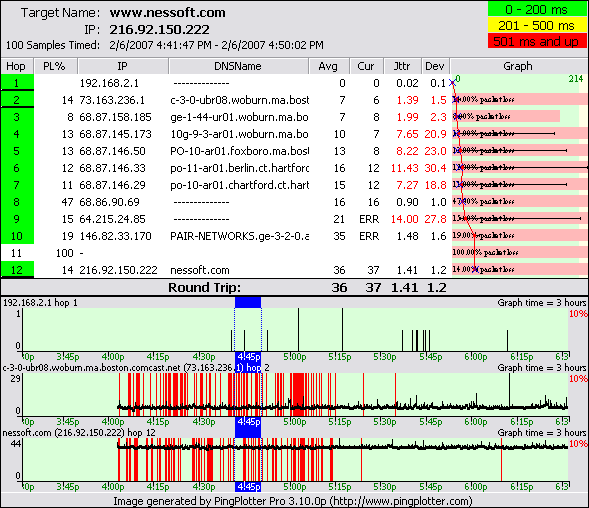Thanks for the email with details, Don.
Your problem is with packet loss, not latency. In the attached picture, notice how hop 2 has significant packet loss - 14% for the time selected that also shows up at the final destination.
Packet loss (especially 10%+ packet loss) makes page times increase dramatically. The TCP protocol is error correcting, which means that any lost packets are resent - but they have to time out first. If your initial timeout (for the TCP protocol) is 2 seconds, then it takes at least 2 seconds to recover from any lost packet. If the data stream you're sending has a number of packets that are lost, it can take a while for the server / client handshaking to figure out which packets were lost and resend them.
Latency would increase the page load time a little bit, but with higher latency (if no packets are lost), the difference in page load time increases just by the amount of the latency. With packet loss, it increases by the timeout, plus the resend time, plus any additional recovery time (if there are multiple lost packets, for instance). This is why you're seeing 20 second delays at 4:45, but very little delays at 6:00pm.
The problem here is between hop 1 (which looks like a device on your network - maybe a firewall or router) and hop 2 (which looks like it's inside your cable complex). This could be a problem with your cable modem, or possibly with the cable line itself.
I would recommend contacting Comcast and tell them about the symptoms you're seeing. They should be able to offer some kind of strategy for solving the problem - maybe sending out a tech, etc. Of course, they will recommend that you reboot your cable modem and try it again. I would already have done that (during a period when you're seeing packet loss in PingPlotter, of course!) so you know if that will help or not. You should also look in PingPlotter for time-of-day when the problems normally happen. If they happen during working hours, don't call them at 8pm because the problem isn't happening then. Use PingPlotter to determine if there's a pattern of time when the problem most often occurs so you can give that evidence to them - and also so you can schedule any work for a period when the problem normally happens.
- Pete
Attachments


